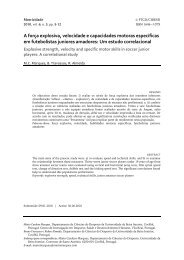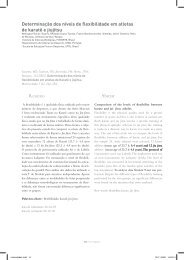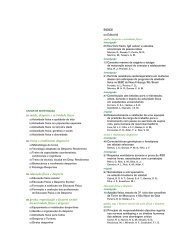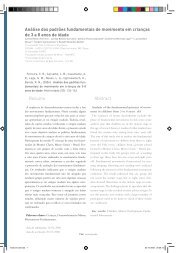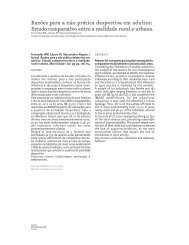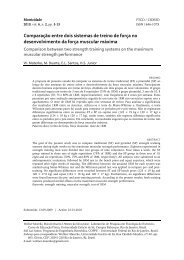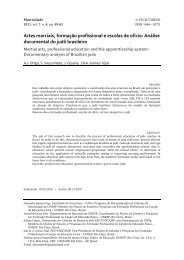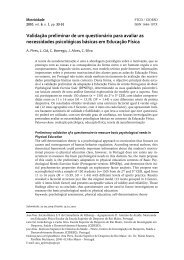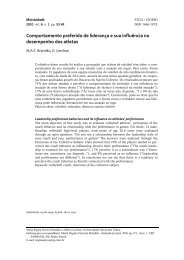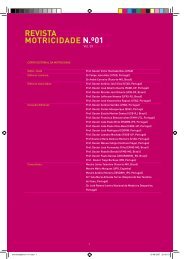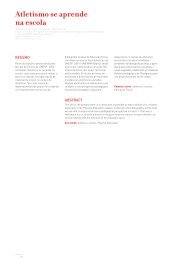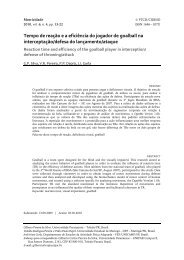revista motricidade
revista motricidade
revista motricidade
- No tags were found...
Create successful ePaper yourself
Turn your PDF publications into a flip-book with our unique Google optimized e-Paper software.
70 | A. Pereira, A.J. Silva, A.M. Costa, E.B. Almeida, M.C. Marques<br />
elite gymnasts compared to controls but was<br />
only significant for males (male: 0% vs 16.1%,<br />
p = .04; female: 5.5% vs 22.7%, p = .39)<br />
(Massidda, Vona, & Calo, 2009). Lucia et al.<br />
(2006) study also found contradictory findings<br />
when comparing a group of 50 top-level male<br />
professional cyclists (26.9 years) with those of<br />
a group of 52 Olympic-class male endurance<br />
runners (26.8 years) and 123 male controls.<br />
The results showed that no significant<br />
differences (p > .05) were found between<br />
groups, suggesting that the ACTN3 R577X<br />
polymorphism does not confer an advantage on<br />
the ability to maintain severe endurance<br />
performance.<br />
The conflicting association results between<br />
ACTN3 and athletic performance in several<br />
studies could be due to the heterogeneity of<br />
the study cohorts. However, the main reason<br />
for such diverge findings is because athletic<br />
status is a complex polygenic trait in which<br />
numerous candidate genes, complex gene-gene<br />
interactions, and several environment-gene<br />
interactions involved (Ahmetov & Rogozkin,<br />
2009; Coffey & Hawley, 2007).<br />
Further, studying young individuals can<br />
disclose genotype × phenotype associations in<br />
complex traits because they have not shared or<br />
were exposed to different factors yet. Clarkson<br />
et al. (2005) studied the associations between<br />
ACTN3 genotype and muscle size, elbow flexor<br />
isometric and dynamic strength in a large<br />
group of men (n = 247) and women (n = 355),<br />
before and after 12 weeks of elbow<br />
flexor/extensor resistance training program. In<br />
men the authors found no association between<br />
ACTN3 R577X genotype and muscle<br />
phenotype but in women homozygous for the<br />
X allele showed lower baseline maximal<br />
voluntary contraction compared with RX<br />
genotype. Furthermore, women with the XX<br />
genotype demonstrated greater absolute and<br />
relative 1RM gains compared with the carriers<br />
of the RR genotype after resistance training. It<br />
seems that the ACTN3 R577X genotype is one<br />
of the many genes that seem to contribute to<br />
the variation in muscle adaptation to an<br />
exercise stimulus, however genotype × muscle<br />
response seem markedly affected by gender.<br />
Another important study about ACTN3 ×<br />
environment interaction was published by<br />
Moran et al. (2007) who studied Greek<br />
adolescent boys (n = 525). The results show<br />
that subjects with XX genotypes took longer<br />
time to realize a 40 meter sprint than RR<br />
genotype (XX = 6.13, RR = 5.92, p = .003)<br />
but these were significantly faster than<br />
subjects with RX genotype (6.00 seconds),<br />
who were, in turn, significantly faster than XX<br />
– raising the possibility of a ‘co-dominant’<br />
effect of the R and X allele – resulting in a<br />
‘dosage’ effect relative to the amount of α-<br />
actinin-3 present in fast fibers. Indeed, further<br />
studies are needed because the potential<br />
heterozygote effect of the ACTN3 genotype has<br />
not yet been studied in any detail in either<br />
mice or humans.<br />
ACTN3 genotype influence on muscle strength<br />
and power in older people<br />
The association between risk factors for<br />
falling and muscle genotypes (or other) can<br />
provide important information in construction<br />
of training programs in older populations. For<br />
that reason it seems quite relevant to consider<br />
whether a particular gene variant (that was<br />
associated with low muscle strength or power)<br />
represents a muscle function disadvantage for<br />
the elderly population. For the first time,<br />
Judson et al. (2011) showed that the functional<br />
ACTN3 R577X genotype represents a genetic<br />
risk factor in older females and reported a<br />
strongest association between R577X genotype<br />
and increased risk of falling (10%-61%). Some<br />
years before, also Clarkson et al. (2005) and<br />
Walsh et al. (2008) observed that women with<br />
the XX genotype had lower baseline elbow<br />
flexor isometric strength compared with<br />
individuals with RR genotypes (p = .05), lower<br />
knee extensor concentric peak torque (p = .01)<br />
and eccentric peak torque (p = .02).<br />
Additionally, Delmonico et al. (2007)<br />
investigated baseline knee extensor concentric<br />
peak power during 10 weeks of unilateral knee



